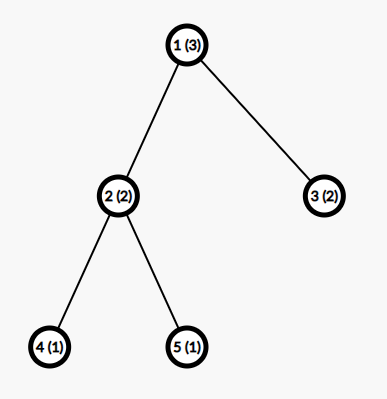| Codeforces Round 949 (Div. 2) |
|---|
| Finished |
Note the unusual definition of $$$\text{MEX}$$$ in this problem.
Piggy gave Turtle a binary tree$$$^{\dagger}$$$ with $$$n$$$ vertices and a sequence $$$a_1, a_2, \ldots, a_n$$$ on his birthday. The binary tree is rooted at vertex $$$1$$$.
If a set of paths $$$P = \{(x_i, y_i)\}$$$ in the tree covers each edge exactly once, then Turtle will think that the set of paths is good. Note that a good set of paths can cover a vertex twice or more.
Turtle defines the value of a set of paths as $$$\sum\limits_{(x, y) \in P} f(x, y)$$$, where $$$f(x, y)$$$ denotes the $$$\text{MEX}^{\ddagger}$$$ of all $$$a_u$$$ such that vertex $$$u$$$ is on the simple path from $$$x$$$ to $$$y$$$ in the tree (including the starting vertex $$$x$$$ and the ending vertex $$$y$$$).
Turtle wonders the minimum value over all good sets of paths. Please help him calculate the answer!
$$$^{\dagger}$$$A binary tree is a tree where every non-leaf vertex has at most $$$2$$$ sons.
$$$^{\ddagger}\text{MEX}$$$ of a collection of integers $$$c_1, c_2, \ldots, c_k$$$ is defined as the smallest positive integer $$$x$$$ which does not occur in the collection $$$c$$$. For example, $$$\text{MEX}$$$ of $$$[3, 3, 1, 4]$$$ is $$$2$$$, $$$\text{MEX}$$$ of $$$[2, 3]$$$ is $$$1$$$.
Each test contains multiple test cases. The first line contains the number of test cases $$$t$$$ ($$$1 \le t \le 10^4$$$). The description of the test cases follows.
The first line of each test case contains a single integer $$$n$$$ ($$$2 \le n \le 2.5 \cdot 10^4$$$) — the number of vertices in the tree.
The second line of each test case contains $$$n$$$ integers $$$a_1, a_2, \ldots, a_n$$$ ($$$1 \le a_i \le 10^9$$$) — the elements of the sequence $$$a$$$.
The third line of each test case contains $$$n - 1$$$ integers $$$p_2, p_3, \ldots, p_n$$$ ($$$1 \le p_i < i$$$) — the parent of each vertex in the tree.
Additional constraint on the input: the given tree is a binary tree, that is, every non-leaf vertex has at most $$$2$$$ sons.
It is guaranteed that the sum of $$$n$$$ over all test cases does not exceed $$$10^5$$$.
For each test case, output a single integer — the minimum value over all good sets of paths.
553 2 2 1 11 1 2 253 2 1 1 11 1 2 261 2 1 2 1 31 2 3 3 472 1 2 3 1 2 11 1 2 2 3 3101 2 2 1 4 2 3 1 2 11 1 2 2 3 3 4 5 5
4 6 6 6 7
In the first test case, the tree is as follows. The number in brackets denotes the weight of the vertex:

The good set of paths with the minimum value is $$$\{(2, 3), (4, 5)\}$$$.
Note that in this test case $$$\{(4, 5)\}$$$ and $$$\{(3, 4), (4, 5)\}$$$ are not good sets of paths because each edge should be covered exactly once.
In the second test case, the tree is as follows:

The set of good paths with the minimum value is $$$\{(1, 2), (1, 3), (4, 5)\}$$$.
In the third test case, the tree is as follows:

The set of good paths with the minimum value is $$$\{(1, 6), (3, 5)\}$$$.
| Name |
|---|




